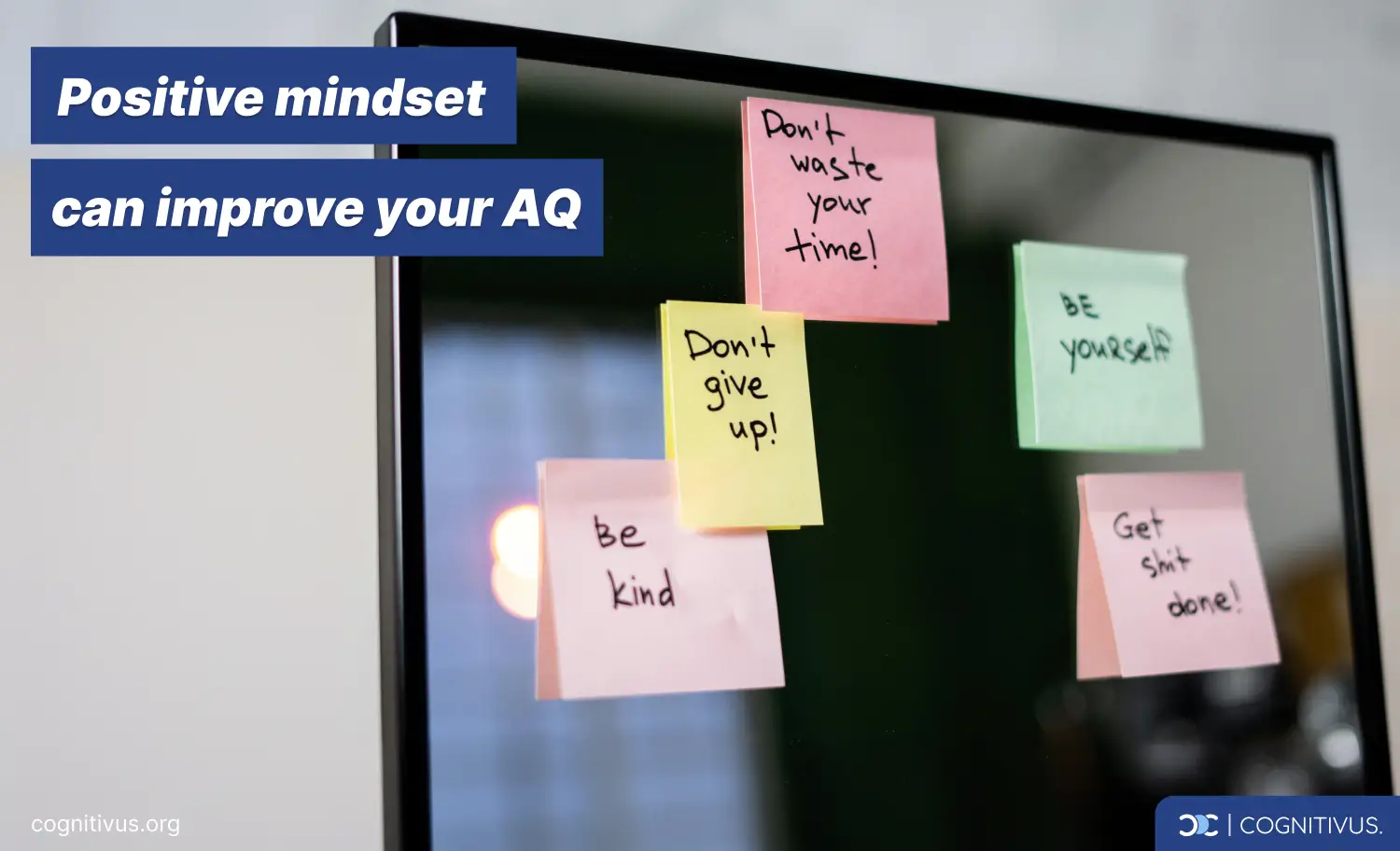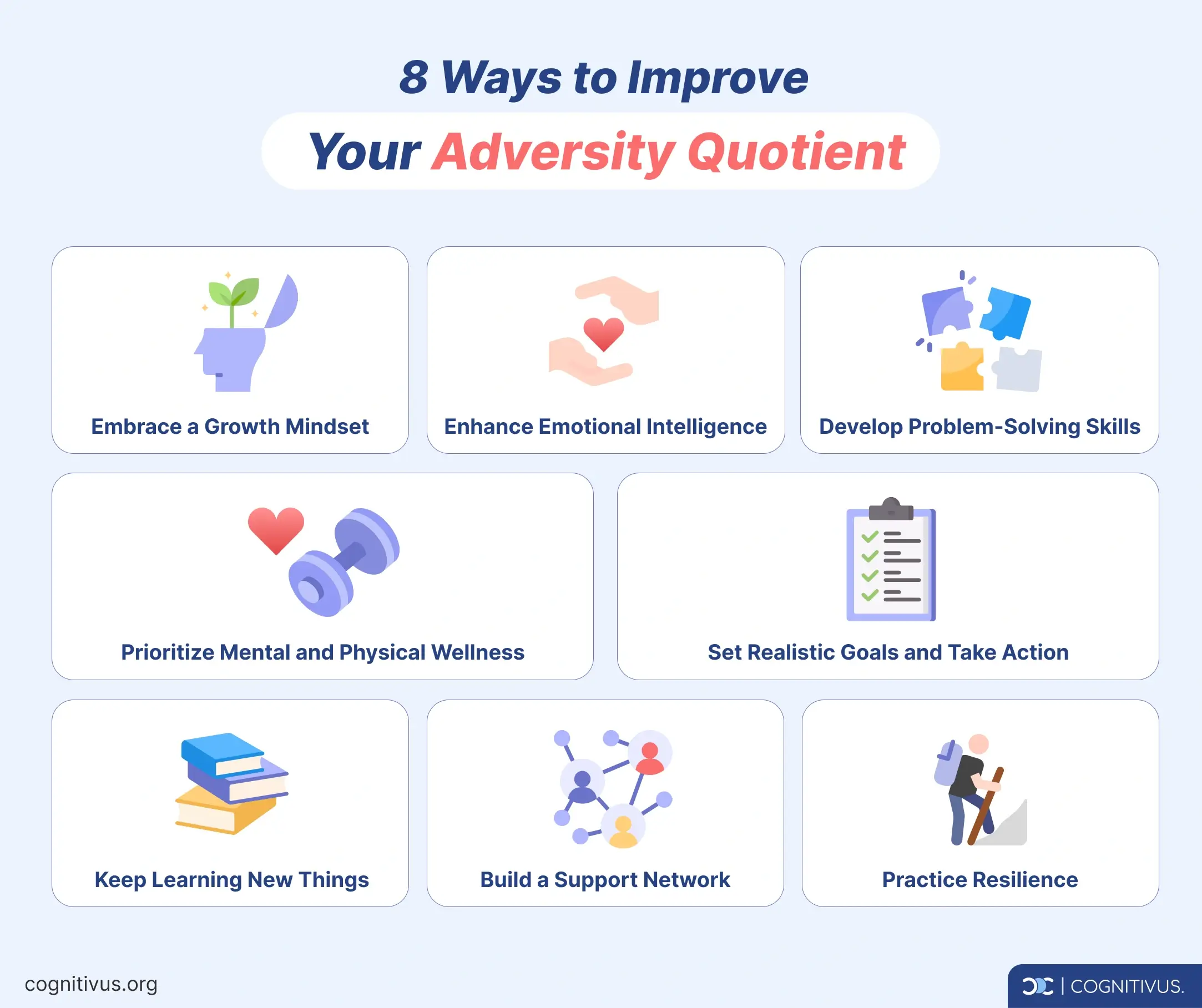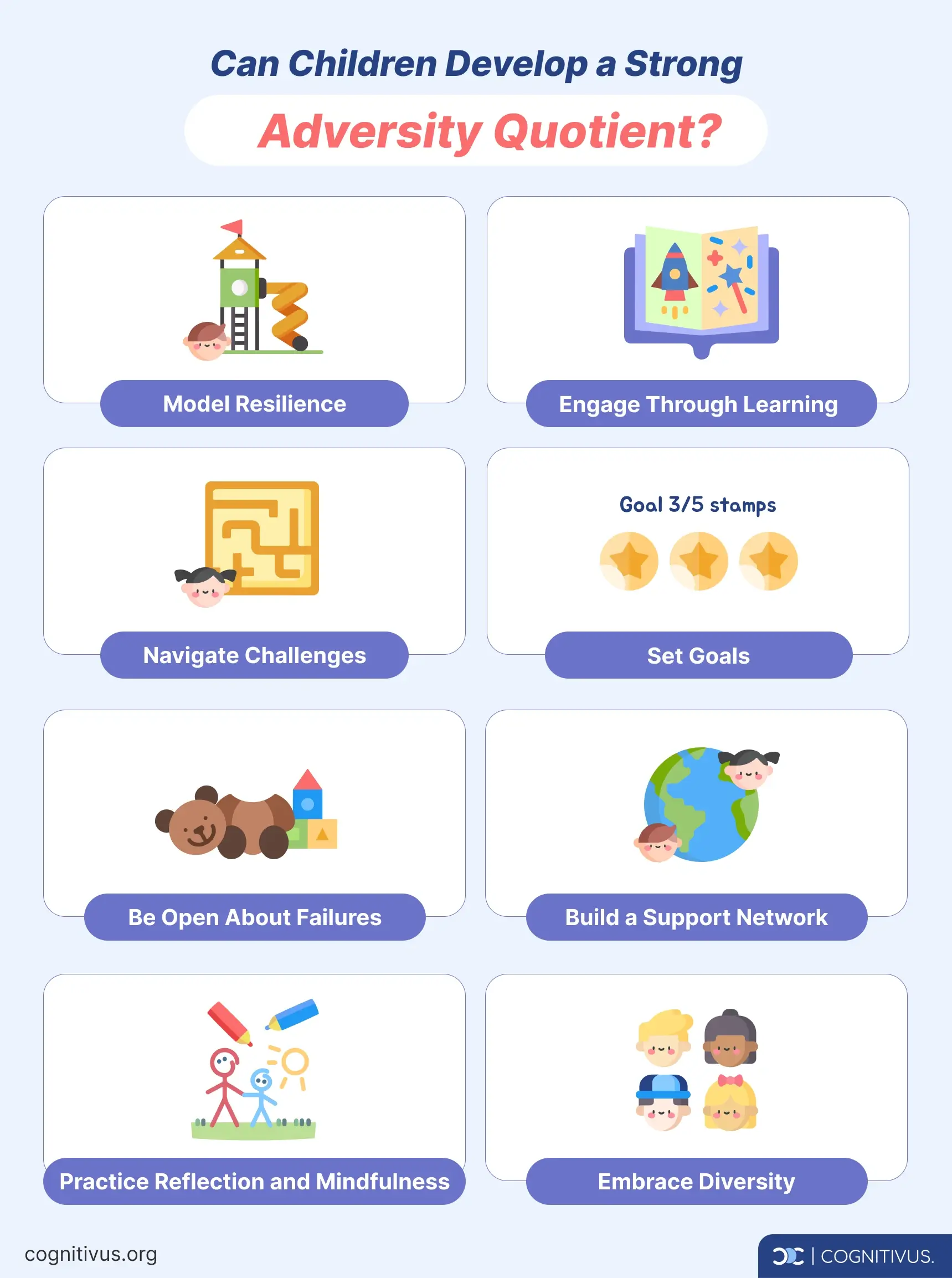Have you ever wondered how some people have incredible resilience in the face of adversity while others seem to fall apart? The answer is in our adversity quotient, otherwise known as AQ.
Everyone has AQ, but some have more than others. Your level of AQ can help you overcome obstacles, which explains why certain people appear to have immense inner strength and motivation through very tough times. But in addition to how well you can cope and move forward, it is also a measure of intelligence.
In this guide, I explain what adversity quotient is, why you need it, and how to strengthen your resilience when obstacles come your way.
Adversity Quotient (AQ) Explained
Your adversity quotient determines how well you can handle pressure and work through challenges. Think of it as your level of inner strength and ability to bounce back from hardships. According to psychologists, it is one of the four measures of intelligence alongside emotional quotient (EQ), which measures emotional intelligence; social quotient (SQ), including social skills; and general intelligence or intellectual quotient (IQ).
You might be thinking, “How can you possibly quantify someone’s resilience and motivation to determine their overall AQ?”
Well, researchers use a combination of tests and tools to assess your adversity quotient. This involves questionnaires and participation in scenarios that reflect real-life struggles and how you’d work through them or react under stress. These assessments analyze different aspects of your coping styles or strategies. Control is one such coping strategy that is measured in terms of how much you believe you have the power or capacity to influence an outcome.
To get an idea of your overall AQ, ask yourself, “Do you tend to give up when faced with obstacles or persevere and seek solutions? Some of the qualities associated with a high adversity quotient include determination, optimism, and flexibility. Understanding whether you have these traits is important because they can help you move forward despite limitations.
The Benefits of High Adversity Quotient
How did you react to a difficult time in your life? Did you feel hopeless and want to give up, or could you think about the situation and find a way to work through it?
One simply cannot deny the benefits of having a high adversity quotient. That’s because your AQ includes the abilities and traits you rely on to adapt to and deal with change. It’s about getting back on the horse, so to speak, and that means “making the effort” no matter how many times you fail or feel defeated.
Based on a research study published in Heliyon, students who were proficient in handling adversities exhibited higher levels of motivation and academic performance during tumultuous times, such as the COVID-19 pandemic. These students possessed stronger levels of independence, learning capabilities, and confidence in their studies, which shows us how AQ can positively impact success and autonomy.
These findings alone show us just how important it is to work on your AQ. By focusing on a positive mindset, motivational attitude, and constructive coping mechanisms, you’re better equipped to work towards your goals and persist in the face of adversity.

If we consider other studies involving AQ, there is a ripple effect when individuals with a strong adversity quotient pass their resilience on to others. This is relevant for teachers and mentors who can model the skills and traits of high AQ in their students. This process teaches learners how to cope and hold their heads up high no matter what they’re going through.
Whether in the classroom, workplace, or your very own home, showing others not to give up through your positivity and strength, can inspire them to be hopeful. It also sets a standard for those around you and cultivates an environment that is primed for overcoming obstacles and thriving under pressure.
All in all, high AQ not only prepares you for personal and professional success but also sets a precedent for those around you.
But if your sense of resilience and positivity is not where you want it to be, let’s explore some of the ways you can work on your adversity quotient.
8 Ways to Improve Your Adversity Quotient
We know that your adversity quotient represents the special traits and qualities you need to tackle challenges, but it’s also a mindset. The stories we tell ourselves, particularly during trying times, influence our thoughts and behaviors. So, when you have a high AQ, you’re better equipped to deal with stress and overcome failure because you believe in yourself.
Fortunately, resilience and a positive mindset can be learned. To better understand this, Dr. Paul Stoltz, a global expert on the theory and practice of human grit and resilience, breaks AQ down in his seminal work. He states that adversity quotient is a dynamic quality that can be developed and strengthened over time, with profound implications for personal growth and career success.
Furthermore, research in the IT industry has shown the substantial benefits of a high AQ in reducing work-related stress, supporting the case for developing this quotient.
To navigate the future successfully, whether in technology, leadership, or any field, adaptability is a non-negotiable asset. It's what differentiates the long-term winners from those unwilling or unable to adapt to the rapidly changing landscape, as highlighted by the BBC.
Today, the question is not if you will face adversity, but when and how you will respond to it. By boosting your AQ, you can respond with resilience, creativity, and a positive outlook.

To grow your adversity quotient, let’s break down the 8 ways to do so:
1. Embrace a growth mindset
The first step toward changing your behavior is to embrace a different attitude. How can you develop inner strength and resilience if you keep telling yourself that you’re a failure when things go wrong or that you give up when obstacles come your way?
To embrace a growth mindset, you must believe that abilities and intelligence can be learned and that challenges should be viewed as growth opportunities rather than obstacles. Practicing this type of mindset every day will work wonders to increase your AQ.
Let’s explain this by looking at the following example:
As the saying goes, “practice makes perfect,” so when you catch yourself in a negative thought, stop, and rethink how to approach the situation in a more constructive light.
2. Prioritize mental and physical wellness
There’s no doubt that a strong mind and body give you the edge to face adversity. If you find yourself stuck in a rut, look at your overall lifestyle. You need regular exercise, a balanced diet, and mindfulness because they all build resilience.
Here’s an example of a quick workout plan:
Simple activities that you enjoy can drastically improve your mood, and when you feel good, it shows!
3. Enhance emotional intelligence
To improve your emotional intelligence, you need to know what it is. Emotional intelligence, which is also called EQ, is your ability to understand and manage your emotions and those of others. Simply put, it’s about recognizing emotions, empathizing with others, and then responding appropriately.
It’s easier to understand the application of EQ in the example below:
This approach shows empathy and assists in creating a supportive work environment.
4. Develop problem-solving skills
When a challenge comes your way, finding the answer isn’t always easy, and this can lead to frustration, stress, and fear. Learning how to problem-solve will help you analyze issues, create solutions, and evaluate the results. The more you practice these skills, the greater your creativity and innovation when dealing with obstacles.
Let’s consider another example below:
The purpose is to get your team members to think outside the box, fostering innovative and creative problem-solving skills.
If you believe that you’re not a great problem solver, the good news is that you can learn these skills with practice. To do this, listen to different perspectives, consider new ideas, and find non-traditional ways of resolving issues. Eventually, you won’t feel so overwhelmed or stressed when challenges come your way.
5. Keep learning new things
Did you know that even the most intellectual people in the world continue to learn new things to broaden their knowledge? I think Albert Einstein sums this up perfectly when he said, “The more I learn, the more I realize how much I don't know.”
Active learning is an excellent way to improve your adversity quotient, as we can see in the recommendation below:
Active learning is another way to help you adapt to change, and it can help you find your purpose.
6. Build a support network
A reliable support system provides encouragement and insight. Surround yourself with people who offer unique perspectives and who genuinely care about you. This way, if you’re going through a hard time, you know that you have someone trustworthy to lean on and help you see things from a different viewpoint.
So, where do you start? Think of the example below:
7. Practice resilience
Resilience is one of the most important qualities when it comes to a high adversity quotient. That’s because it involves our ability to recover from setbacks and face challenges with courage and persistence. Someone with a low adversity quotient is likely to give up quickly when confronted with the initial challenges.
Perhaps an example of applying resilience in a real-life setting can explain why it’s necessary for AQ:
8. Set realistic goals and take action
The reason that goal setting is such a necessary part of building a high adversity quotient is because it provides us with a sense of direction and motivation. I know the feeling when an unexpected challenge comes your way and you just don’t know how to deal with it. The more you think about it, the bigger the problem becomes.
Breaking a large challenge into smaller actionable steps, makes it more manageable. If you don’t know where to start, you can ask friends and family for help or reach out to a professional for guidance.
Let’s take a look at an example of goal setting:
Think of celebrating the small wins so you can stay motivated throughout the process.
Working on Your Adversity Quotient and Why It’s Important
If we didn’t have the tools and awareness to help ourselves through difficult times, we’d rarely succeed in relationships, in our careers, and in achieving our goals and dreams.
If you know that your AQ is something that you need to work on, then focusing on areas such as a growth mindset, mental strength, and resilience can give you the tools you need to move forward. Additional qualities, including emotional intelligence, problem-solving skills, and creativity, encourage curiosity and the desire to learn and experience more.
The purpose of adopting the 8 steps mentioned above is to increase your AQ to enhance your flexibility, robustness, and adaptability. This allows you to turn obstacles into stepping stones for success.
How to Apply Adversity Quotient in Your Life
Now that you’re familiar with the steps to increase your adversity quotient, how do you apply AQ to your life? We explore ways to implement adversity quotient in leadership and the steps you should take to manage stress.
AQ allows you to set goals and establish leadership
When applying your adversity quotient to your life, particularly in leadership, goal-setting can build resilience. Goals provide direction and motivation, which show you how to face adversities in a healthy way.
In the workplace, whether you are leading yourself or a team, clear objectives offer guidance during times of uncertainty. They steer you and your team toward success despite the challenges. By setting achievable yet ambitious goals, you can maintain focus and determination through those hard periods.
AQ helps you become a better leader
A high AQ leader is equipped to inspire their teams to persevere through setbacks. They show others resilience and inner strength through their actions, from the way they communicate to their body language.
According to Paul Stoltz’s ‘Adversity Quotient at Work’ inspirational leaders create an environment that treats challenges as a path towards greater achievement. By embodying the principles of AQ, leaders set the tone for their teams. This allows them to instill the same qualities in their employees, which builds a resilient, adaptive, and capable workforce.
AQ makes it easier to manage setbacks and stress
A strong AQ is one of the best ways to manage setbacks and stress. We know that adversity is something that we all experience at some point, and emotions such as stress and anxiety usually accompany it. When you rely on your AQ, you don’t see setbacks as barriers but as temporary obstacles that can be navigated successfully. In summary, your AQ can help you bounce back stronger and wiser from life’s downs, and that defines resilience.
I want you to remember that stress is a normal part of life, and for many people, short-term stress and anxiety motivate them to make positive changes. But when stress is chronic and disruptive, understanding how to manage it can mean the difference between a negative attitude and using it as a catalyst for growth. In the workplace, problems can be seen as an opportunity for improvement and learning, as suggested by Keith Krach in his Forbes article on “Hiring for Adversity.”
Can Children Develop a Strong Adversity Quotient?
If you are a parent, you only want the very best for your child, and that means equipping them with a strong adversity quotient. AQ should be seen as a crucial part of their development because it helps them navigate both academic and general life challenges with resilience.
To get them on the right path, below are a few comprehensive strategies and examples to develop and improve your child’s adversity quotient:

1. Model resilience
Strategy: Your child learns by watching you. So the simplest way to instill a sense of strength in them is to demonstrate how to manage stress constructively and maintain a positive outlook in difficult situations.
If your child is working on a school project at home and it doesn’t go as planned, instead of becoming frustrated, calmly figure out a solution. Carefully explain the thought process to your child. This teaches them problem-solving and calmness under pressure.
2. Encourage engagement through learning
Children learn through modeling, peer interactions, and practice, so we know that creating a supportive learning environment is an excellent way to enhance their AQ. A 2023 study that involved teachers with high teaching competence revealed that engaging lessons and awareness of student diversity directly affected the students’ enthusiasm and participation.
Strategy: Encourage educators to adopt engaging teaching methods and understand diverse student needs. Creating this type of environment can significantly impact your child's enthusiasm for learning.
If your child struggles with traditional learning methods, suggest practical projects or interactive activities in their learning. This approach can improve their engagement and resilience when they encounter academic challenges.
3. Teach them to navigate everyday challenges
Strategy: Use daily setbacks as learning opportunities. Guide your child through resolving minor conflicts or disappointments with care and patience. This teaches them the skills they need to overcome difficulties and not see themselves as failures.
If your child is upset about not making a sports team, discuss what they might do differently next time, like additional practice to improve their abilities. Show them that setbacks are growth opportunities.
4. Encourage goal setting
Strategy: Help your child set their own goals and allow them to dream big. These steps can develop a sense of ownership and determination.
Work with your child to set a reading goal and track his or her progress together. Celebrating small achievements reinforces persistence and the joy of reaching personal milestones.
5. Promote openness about failures
Strategy: Help them understand that failure is a normal part of learning and growing. Create open discussions about mistakes and struggles and emphasize their role as learning opportunities.
Share a personal story of a failure and what you learned from it at a family dinner. You can create an environment where setbacks are viewed as stepping stones rather than endpoints.
6. Help them build a support network
Strategy: Ensure your child knows they have an unconditional support system of family, friends, and mentors they can depend on.
Encourage your child to discuss their challenges with trusted individuals. Show them just how important it is to lean on others and to find strength in their support system when facing challenges.
7. Teach them reflection and mindfulness
Strategy: Reflection and mindfulness are important self-awareness strategies that you can use to teach children how to tune into and regulate their emotions.
Practice simple mindfulness exercises together, such as deep breathing, meditation, or expressing gratitude. These can help your child find inner peace and perspective in stressful situations.
8. Expose them to diversity
Strategy: Enrich your child’s experiences by introducing them to diverse cultures and perspectives. This can help them develop empathy and adaptability.
Participate in cultural events, read stories from various cultures, or engage in community services. The purpose is to teach your child the value of understanding and appreciating differences.
Why AQ Is Integral in Shaping Our Lives
No matter which way you look at it, your adversity quotient can help you improve your resilience and get through some of the most stressful situations in your life. Every one of us needs a sense of inner strength and motivation to work through the challenging and hard times that can leave us feeling hopeless.
The good news is that even if you think that your AQ needs work, you can improve it by developing your problem-solving skills, creativity, emotional intelligence, and motivation to learn new things. This form of intelligence is not only important for personal growth in adults but also for children who can take these crucial skills into adulthood.
Always remember that setbacks in life may happen, but that doesn’t mean that you don’t have a rewarding and bright future. Strengthening your adversity quotient will give you the tools, clarity, and guidance you need to achieve more and be more.


